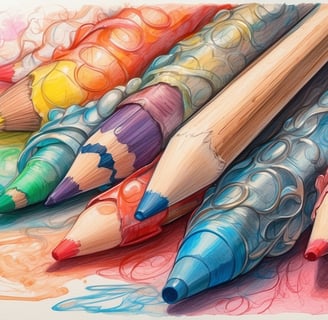Can I Blend Colors Using Markers?
A Comprehensive Guide for Beginners
12/28/20233 min read


Blending colors is a crucial technique in the world of art, especially for those who love working with markers. This post is designed to guide beginners on how to blend colors effectively using markers, a skill that can elevate your coloring projects to a new level of creativity and professionalism.
1. The Art of Blending with Markers
Blending with markers is not only possible but also a popular technique among artists. It involves seamlessly merging different colors to create gradients, shadows, and depth, enhancing the overall appeal of your artwork.
2. Understanding Marker Types
Types of Markers: The two primary types of markers are alcohol-based and water-based. Alcohol-based markers are renowned for their blendability and vibrancy, while water-based markers are known for their ease of use and being less prone to bleeding.
Brands to Consider: Brands like Copic, Prismacolor, and Tombow are popular among artists for their quality and blendability.
3. Basic Techniques for Blending Markers
Layering: This involves applying one color over another to create a new shade or transition.
Feathering: A technique where colors are applied in a flicking motion, allowing them to merge at the edges.
Tip-to-Tip Blending: A method where you touch the tips of two different markers together to create a temporary blend.
4. Choosing the Right Paper
Importance of Paper Quality: The type of paper you use can significantly affect your blending. Thick, smooth, non-textured paper is ideal for markers.
Recommended Papers: Papers like Bristol board or heavyweight marker papers are excellent choices for blending markers.
5. Color Selection and Harmony
Understanding Color Theory: Knowing which colors blend well together is essential. A basic understanding of color theory can help in selecting compatible colors.
Creating a Color Palette: Start with a small, harmonious color palette and gradually expand as you become more comfortable with blending.
6. Practicing Gradient Blends
Simple Exercises: Begin with simple exercises like blending two colors in a gradient, then progress to more complex combinations.
Observing Light and Shadow: Understanding how light and shadow work can help you create more realistic and dynamic blends.
7. Advanced Blending Techniques
Creating Textures: Use blending to create textures like wood grain, fabric, or skin tones.
Layering Different Colors: Experiment with layering different colors to see how they interact and create new hues.
8. Dealing with Challenges in Marker Blending
Avoiding Over-Saturation: Be cautious of applying too much ink, which can lead to bleeding.
Dealing with Streaks: Use consistent, even strokes to avoid streaks and achieve smoother blends.
9. Tools to Aid in Blending
Blending Markers: Some brands offer colorless blending markers, specifically designed to help blend colors.
Paper Stumps and Blending Brushes: These tools can be used to soften and blend marker ink on the paper.
10. Digital Alternatives for Blending
Digital Coloring: Software like Procreate and Adobe Photoshop offers digital blending tools that mimic the effect of marker blending.
Benefits of Digital Blending: Digital tools provide more control and the ability to undo, which can be helpful for beginners.
11. Practice and Patience: Key to Mastering Blending
Regular Practice: Consistent practice is crucial in mastering blending techniques.
Learning from Mistakes: Don’t be discouraged by mistakes; they are an important part of the learning process.
12. Finding Inspiration and Resources
Online Tutorials: There are numerous online resources, from YouTube tutorials to art blogs, where you can learn and get inspired.
Art Communities: Joining art communities can provide support, feedback, and additional tips for blending with markers.
Final Thoughts
Blending colors with markers is a skill that can dramatically enhance your coloring projects. With the right tools, techniques, and practice, beginners can achieve smooth, professional-looking blends that bring their artwork to life. Remember, the journey to mastering blending with markers is unique to each individual. Embrace the learning process, experiment with different techniques, and most importantly, have fun with your artistic explorations.
